In-Season Strength Training: Is ‘Light and Fast’ Is A Huge Mistake?
Strength & ConditioningABOUT THE AUTHOR

Rob Van Valkenburgh
Rob Van Valkenburgh joins the TrainHeroic blog with 10 years experience in the strength game. Having coached elite athletes in both the private sector and the Division 1 collegiate setting, Rob believes that strength has to be the foundation of all athletic movement and that athletes of all levels deserve a comprehensive strength program. Rob writes regularly on his own website FootballStrengthCoach.com where here shares short form articles, training tips & programs, and other items related to strength and performance for football.
For the last 9 months you have trained hard and heavy getting ready for the season. You don’t want to piss away that progress, do you?
In this article, I am going to outline how to build strength and power during an in-season training phase and how to stay fresh while still training aggressively. In addition, we will dive deep into how you can still lift heavy and be powerful late in the season when strength matters most.
Now, a majority of coaches will say the key to an effective in-season strength program is to train ‘light and fast’… Well, to be completely honest, I could not disagree more.
Don’t get me wrong, you want to spend a short duration in the weight room (45 minutes or less), but I just can’t get on board with the whole ‘train light’ aspect of this traditional way of thinking. In my opinion, this way of programming is an excuse for a coach not to think outside of the box when it comes to set/reps schemes, loading parameters, and daily recovery protocols.
The goal of any quality strength program is, and always will be, to allow your athletes to perform at a high level when it matters most. For high school football players and teams, what matters most are conference games, the playoffs, and (if you’re lucky) the state championship game.
It’s common knowledge that without any maintenance work, strength levels begin to dip after two weeks. So, knowing this, you will have to implement a very regimented training protocol in order to ensure your athletes are firing on all cylinders late in the season, when your competition is beginning to wear down.
But, don’t take my word for it…

In the week leading up to last year’s super bowl, the New England Patriots were squatting at 80% of their max and their players found that to be a serious competitive advantage late in the game when their strength mattered most.
“We paid a serious price to get to this point. We put in a lot of work. We’re practicing in pads on Super Bowl week. We’re squatting 80% of our maxes on Super Bowl week. I mean, we worked for this. Our bodies were ready. Our minds were ready.”
– Matthew Slater (Patriots Wide Receiver – Super Bowl Champion)
Of course, you will have scheduling considerations and will have to be very careful not to program too aggressively, which would cause an excessive level of fatigue. When you are in-season, the number one thing you want to avoid is getting beat down to the point where performance is hindered.
That said, if you follow a structurally sound program, your performance will not be impacted and you will be able to see strength/power improvements.
So, how do you approach programming during the in-season phase?
It is important to have a series of programming strategies you will put into play with your training program to ensure your athletes continue to build strength while performing at a high level through this entire season.
// Squat Heavy, But Be Smart
The first and most important component of an effective in-season program is to be strategic and smart with your heavy squat days.
If you have a 5-7-day break between games, use that gap to schedule a heavy squat day as far from competition as possible. For example, if you have a game on a Friday night and don’t play again for seven days, then use Saturday to squat heavy. This gives you six days to recover before their next game. In addition, squatting following a game helps aid in recovery and allows the athletes to work through some soreness. Also, from a coach’s perspective, it gets your athletes back into a training routine and off the couch on Saturday.
Now, a Saturday lift is not always an option. In this case, have them lift on Monday and be a little more cautious with your sets, reps, and training loads. If you are squatting on a Monday, you will want to cut back the total volume by 15%-20% to account for the shortened recovery time.
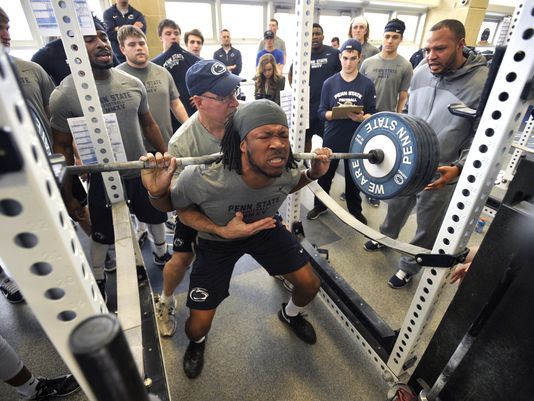
// Cluster Your Primary Movements
Now, if you want this to work, you are going to have to crank up the weight. Typically, you will want to lift above 80% of your 1 rep max. Your sets would look something like this:
Of course, there are a number of other variations you can use for a cluster set, but I like the 10X2 or 6X3 setup. This allows you to get 18-30 reps in at 80% or above, which builds power better than a typical set/rep scheme. Look at it like this: since the per set rep range is low, it will limit the time under tension when compared to a rep scheme of 3X8 or 4X5.
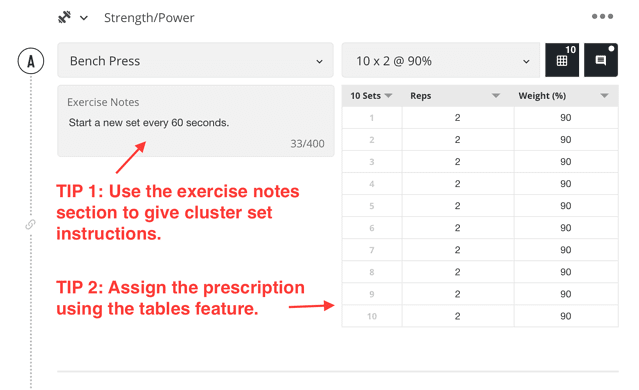
Programming Tools Powered by TrainHeroic
// Cleans for Throws; Snatches for Jumps
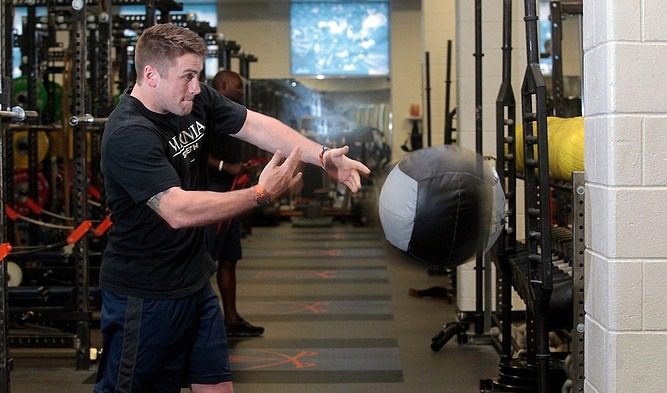
As the season progresses, you will want to put a large emphasis on replacing your high impact movements such as Power Cleans and Snatches with Med Ball Throws, Plyometric Jumps, and Horizontal Bounds.
Throws, jumps, and bounds should be a staple of your year-round training approach because they do a great job of developing power and teaching triple extension. But as the physical toll of the season progresses, it is important to limit the amount of physicality you are forced to embrace. Each of these three movements can be a great substitution for Olympic lifts and can be used with all athletes in your program in order to continue training for explosive power development.
In my programs, by the 6th week of the season (typically Microcycle 3), I will not perform a catch on an Olympic lift, and I will replace a great majority of my Olympic training volume with throws, jumps, and bounds.
// Reset Their Systems
Now that you are armed with these strategies I am going to share with you the secret sauce that makes this aggressive approach to in-season training so effective. Directly following every training session, and ideally every practice, I will have my athletes perform a nervous system reset.
If you look at the cumulative effect of a football season, an athlete can be performing as many as 10 ‘training sessions’ each week when you factor in practices, strength training sessions, and games.
The science behind this nervous system reset is to take their nervous system from a ‘fight or flight’ state back to a parasympathetic state where they can get directly into recovery. Without this, you will be at an elevated state for quite some time before your body is able to function in a recovery mode. As a coach, it is vital to account for the toll training takes on your athlete’s nervous system.
Coaching Point: When athletes don’t elevate their feed, they miss key benefits that can enhance their breathing. Make sure they are close to a wall with their feet elevated and are focused on the drill and not just resting.
What I have my athletes do is lay on their backs with their legs up a wall with at least a 45-degree angle.
From there, they will close their eyes and perform five minutes of ‘box breathing’. Box breathing is the tempo at which the athletes work through each breath. For this, I have them inhale through their nose for four seconds, then hold their breath for four seconds, then exhale through their mouth for four seconds, and finally, they will hold their breath for another four seconds before repeating this cycle. This gives them a 4-4-4-4 breathing tempo.
I know this sounds like some new-age hippie stuff but give it a try for yourself. Again, with the amount of toll the season takes on an athlete’s body, we would be doing our athletes a disservice by not implementing some form of nervous system reset.
// But How Many Training Sessions?
Now, with all that information the question arises: how many training sessions should be done during the week?
Typically, I recommend starting with three days per week during the pre-season and non-conference play, then cutting it down to two days per week once the season ramps up into the more important competition. The training sessions should be limited to 45 minutes and scheduled at a time that lines up with their practice schedule.
So, what does a week’s training outline look like? For this, I’ll lay out a three-day training split which can be used during the entire season. If your team has time constraints, all you have to do is drop the third training day.
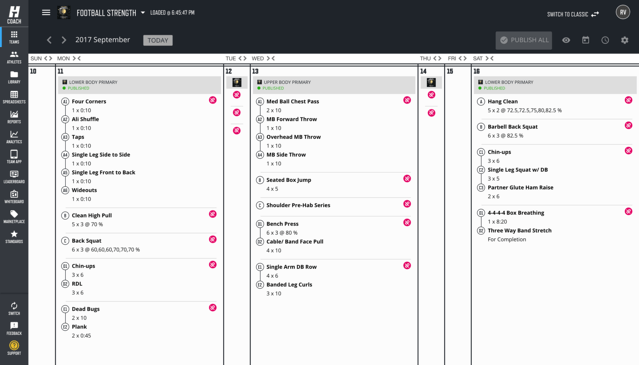
Here’s how a full week of training will look if playing on a Friday. Day 1 (Monday) is the Lower Body Primary, Day 2 (Wednesday) is the Upper Body Primary. Add an optional lift on Day 3, and then get right back to the meat of the program on Saturday, starting back on Day 1.
Your Title Goes Here
Your content goes here. Edit or remove this text inline or in the module Content settings. You can also style every aspect of this content in the module Design settings and even apply custom CSS to this text in the module Advanced settings.
Day 1: Primary Squat Day
- Ideal Day: Saturday, Sunday, or Monday
- Goal: Primary Lower Body Strength Day
Block 1: Dynamic Warm Up
- General Blood Flow, Mobility and Stability, CNS Activation
Block 2: Power
- Hang Clean or Hang Clean High Pull
- Ideal Sets/Reps: 4X4, 5X3
Block 3: Strength
- Back Squat or Box Squat using a Cluster Set approach
- Ideal Sets/Reps: 6X3, 8X2 @ 80%-90%
Block 4: Auxiliary Movements
- Upper Pull: Chin Ups and Row Variations
- Single Leg Push: Single Leg Squat, Split Stance Squat
- Knee Dominate Pull: GHD, Glider Leg Curls
Block 5: Recovery
- Hip/Hamstring Mobility
- Foam Roll areas of soreness
- CNS Recovery – Wall Series w/ 4-4-4 Breathing Tempo
Day 2: Primary Bench and Lower Body Pull Day
- Ideal Day: Monday, Tuesday, Wednesday
- Goal: Upper Body Strength, Lower Body Power
Block 1: Dynamic Warm Up
- General Blood Flow, Mobility and Stability, CNS Activation
Block 2: Power (Lower Body Pull)
- Clean Grip Pull or Speed Deadlift w/ Trap Bar
- Ideal Sets/Reps: 5X3, 6X2 @ 85%-92.5%
Block 3: Strength
- Bench Press or 3 Board Bench using a Cluster Set approach
- Ideal Sets/Reps: 6X3, 8X2 @ 80%-90%
- Superset w/ Face Pulls or Band Pull Apart
Block 4: Auxiliary Movements
- Upper Push: DB Incline Bench, DB Shoulder Press
- Hip Dominate Pull: BB RDL
- Core Stability: DeadBugs, Pallov Press
- PreHab: Neck, Shoulder, Ankle
Block 5: Recovery
- Hip/Hamstring Mobility
- Foam Roll areas of soreness
- CNS Recovery – Wall Series w/ 4-4-4 Breathing Tempo
Day 3: Mindset Lift and Extra Needs
- Ideal Day: Thursday
- Goal: Look Good, Feel Good, Play Good
Block 1: Dynamic Warm Up
- General Blood Flow, Mobility and Stability, CNS Activation
Block 2: Specific Needs and Injury Prevention
- Specific to each individual athlete. Each should have a specific corrective exercise or injury prevention protocol.
Block 3: Gun Show
- Choose 3-4 exercise for the bicep, triceps, and upper back. This will not increase any soreness or fatigue.
(Note: This third day is not necessary for every team. But, what I love about it is it gives the athletes a time to just have fun in the weight-room. It breaks up the monotony of the training/practice week and lets the team have some freedom. Also, training should help the mind, body and soul. This lift is good for the soul.)
// Parting Tips
However, if you approach your recovery and nervous system work the correct way, this should not be a major issue.
Remember, in its purest form, football is a game of physicality played at an extreme rate of speed. If you train properly through your in-season phase, you will have the ability to impose your will while aggressively embracing physicality late in the season when opposing teams are wearing down.
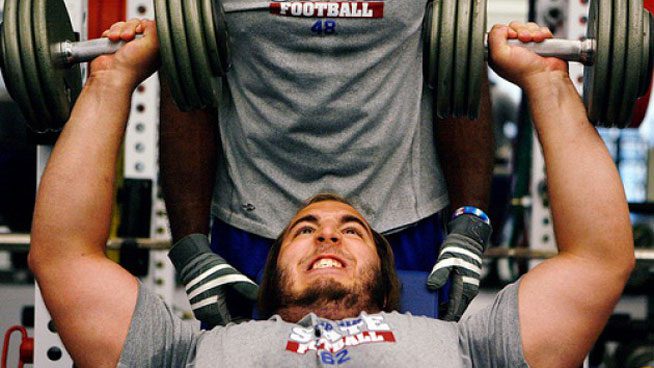
Are you a better coach after reading this?
More coaches and athletes than ever are reading the TrainHeroic blog, and it’s our mission to support them with useful training & coaching content. If you found this article useful, please take a moment to share it on social media, engage with the author, and link to this article on your own blog or any forums you post on.
Be Your Best,
TrainHeroic Content Team
HEROIC SOCIAL
HEROIC SOCIAL
TRAINING LAB
Access the latest articles, reviews, and case studies from the top strength and conditioning minds in the TH Training Lab

